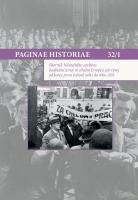Decembrový štrajk roku 1920 na Slovensku a jeho dôsledky
December Political Strike in Slovakia in 1920 and Its After-Effect
Author(s): Ferdinand VrábelSubject(s): History, History of ideas, Social history, Recent History (1900 till today), Interwar Period (1920 - 1939), History of Communism
Published by: Národní archiv
Keywords: Slovakia 1920; december strike; Czechoslovakia 1918-1938
Summary/Abstract: From the establishment of Czechoslovakia – especially during 1919–1920 – there was first an ideological and later an armed struggle for the unity of the new state’s territory (Bohemian borderland, Seven-Day War in Cieszyn Silesia, and fights in Slovakia) that not only laid the foundations for the Czechoslovak Army, but also set the main principles for the internal structure of Czechoslovakia.The Slovak proletariat was smaller and less experienced than its Czech counterpart. Furthermore, social democracy had fewer adherents in Slovakia and the clerical Slovak People’s Party spearheaded by Andrej Hlinka controlled the local political scene. On 19 March 1919 fifty-one members of social democracy and trade unions gathered at a conference in Trenčín to criticise the Slovak authorities. The participating social democrats and government representatives Lehocký and Horváth tried to appease the delegates with a coupon for the supply of forty carriages of flour to the Trenčín district. Yet, they became a target for criticism just like the representatives of the Bratislava headquarters of social democracy.Forty-two districts, accounting for 53% of the Slovak districts, joined the December strike. The Bratislava district was not affected despite a huge concentration of industrial workers. Similarly, the miners of Handlová and workers of Horní Nitra did not go on strike. The general strike terminated the period of political instability with an open clash of two factions in the social democratic party. As a consequence, a new political organisation was established at the social democracy congress in May 1921 where the left wing of social democrats declared themselves the Communist Party of Czechoslovakia. Social democracy lost the majority of its members and the party’s position weakened. The Republican Party of Farmers and Peasants (Agrarian Party) assumed the role of the largest political party in Czechoslovakia.Interestingly, the congress of the Marxist left of Slovakia and Carpathian Ruthenia resulting in the establishment of the Communist Party of Slovakia was held in Ľubochňa on 16–17 January 1921 rather than in a centre of industry with a great number of workers.
Journal: Paginae Historiae
- Issue Year: 32/2024
- Issue No: 1
- Page Range: 328-334
- Page Count: 7
- Language: Slovak

